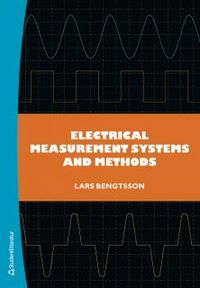
Electrical Measurement systems and methods Upplaga 1
This book treats a wide range of aspects on electrical measurement systems and the methods used to acquire data from electronic systems. That includes sensors and sensor design, amplifiers such as differential and charge amplifiers, ADCs and DACs, digital oscilloscopes, cable theory and probes, noise and noise coupling, common and normal mode signals. This first part (chapters 1-8) doesn’t require any advanced mathematics and is aimed towards undergraduates.
The second part (chapters 9-17) is on an advanced level (master level) and treats transform theory (Fourier, Laplace, z) and how to handle signals in frequency space. We cover the sampling theorem (Nyquist), resolution bandwidth, frequency spectrum distortions like aliasing and leakage and how to apply windows in a frequency spectrum. We also cover systems and signal processing in time-space, including convolution and correlation, filter theory and filter design (both analog and digital). The last chapters concern the statistical aspects on measurement systems and signals, like point and interval estimations, curve fitting and uncertainty estimations according to the GUM method.
Upplaga: 1a upplagan
Utgiven: 2014
ISBN: 9789144103884
Förlag: Studentlitteratur AB
Format: E-bok
Språk: Svenska
This book treats a wide range of aspects on electrical measurement systems and the methods used to acquire data from electronic systems. That includes sensors and sensor design, amplifiers such as differential and charge amplifiers, ADCs and DACs, digital oscilloscopes, cable theory and probes, noise and noise coupling, common and normal mode signals. This first part (chapters 1-8) doesn’t require any advanced mathematics and is aimed towards undergraduates.
The second part (chapters 9-17) is on an advanced level (master level) and treats transform theory (Fourier, Laplace, z) and how to handle signals in frequency space. We cover the sampling theorem (Nyquist), resolution bandwidth, frequency spectrum distortions like aliasing and leakage and how to apply windows in a frequency spectrum. We also cover systems and signal processing in time-space, including convolution and correlation, filter theory and filter design (both analog and digital). The last chapters concern the statistical aspects on measurement systems and signals, like point and interval estimations, curve fitting and uncertainty estimations according to the GUM method.
Begagnad bok (0 st)
Varje vecka tillkommer tusentals nya säljare. Bevaka boken så får du meddelande när den finns tillgänglig igen.



